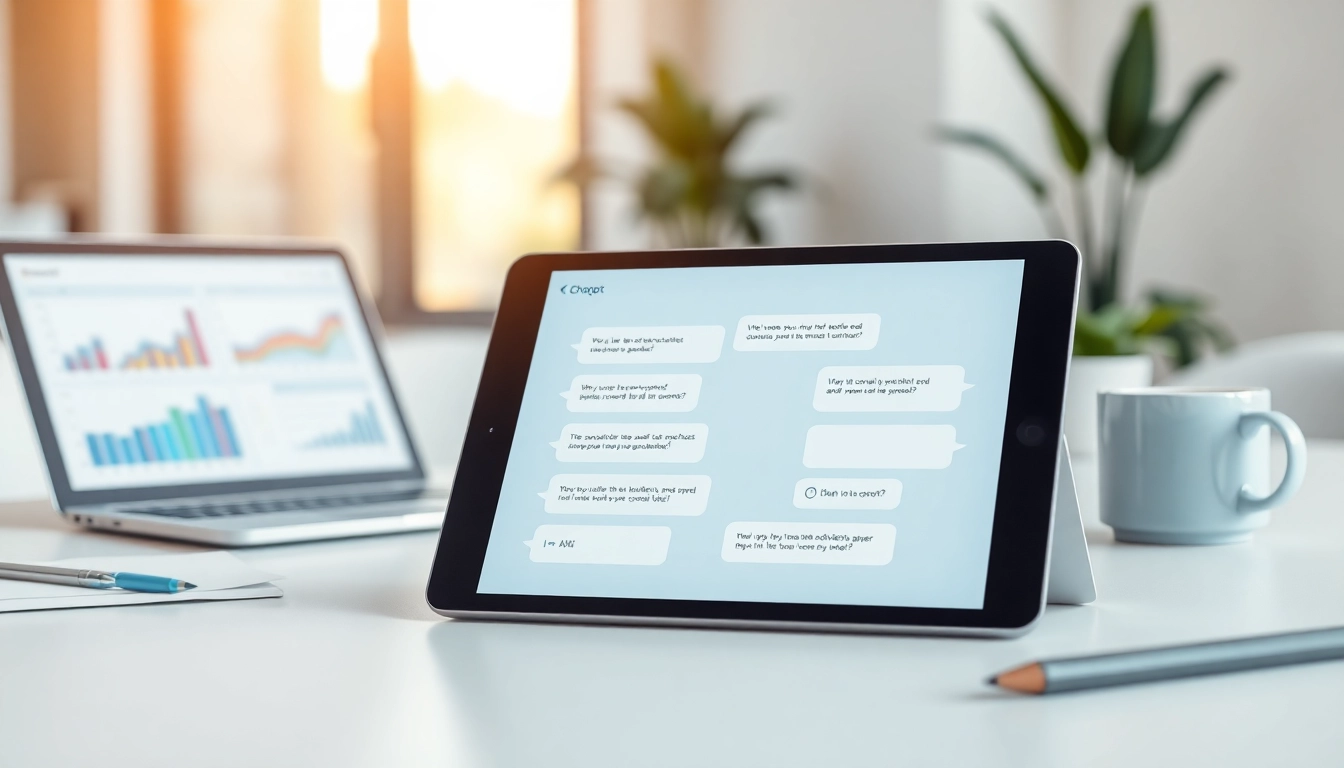Understanding the chatgpt Chatbot
What is a chatgpt Chatbot?
A chatgpt chatbot is an artificial intelligence-driven conversational agent developed using OpenAI’s GPT (Generative Pre-trained Transformer) technology. These chatbots are designed to interact with users in a more human-like manner, capable of understanding and generating natural language responses. Unlike traditional chatbots, which often rely on predetermined scripts, chatgpt chatbots are equipped with sophisticated algorithms that allow them to learn from interactions, adapt to user preferences, and provide nuanced responses based on context.
Features and Benefits of chatgpt Chatbots
chatgpt chatbots come packed with a variety of features that enhance their functionality and user experience:
- Contextual Understanding: They can maintain the context of conversations over multiple exchanges, allowing for more coherent dialogues.
- Natural Language Processing: Their advanced NLP capabilities enable them to understand user sentiments, intentions, and emotions.
- Scalability: chatgpt chatbots can handle numerous interactions simultaneously, making them ideal for businesses with high customer engagement.
- 24/7 Availability: Unlike human agents, chatbots can operate round the clock, providing immediate assistance to users at any time.
- Cost Efficiency: By automating customer interactions, businesses can significantly reduce operational costs while improving service quality.
How chatgpt Chatbots Work
chatgpt chatbots operate through a combination of machine learning, natural language processing, and neural networks. Here’s a breakdown of how they function:
- Data Input: The chatbot receives input from users in the form of text or voice.
- Understanding Intent: Utilizing NLP, the chatbot analyzes user input to determine the intent behind the question or request.
- Generating Responses: Based on the understood intent, the chatbot leverages training data to generate relevant, context-aware responses. This is often done through deep learning models trained on extensive datasets.
- Learning and Adapting: As the chatbot interacts with users, it continuously learns and adapts its responses based on feedback and interactions.
Setting Up Your chatgpt Chatbot
Choosing the Right Platform
Setting up a chatgpt chatbot begins with selecting the most suitable platform. Various platforms offer different levels of support, integration capabilities, and ease of use. Key considerations include:
- Integration Capabilities: Ensure the platform can integrate seamlessly with your existing tools, such as CRM systems, social media, and web interfaces.
- User-Friendliness: Choose a platform that allows for easy customization without requiring extensive technical knowledge.
- Support and Documentation: Adequate support from the platform provider is critical, as good documentation can significantly ease the setup process.
Customizing Your Chatbot Experience
Customization is essential to enhancing user engagement and satisfaction. Businesses can tailor their chatgpt chatbots by:
- Defining Personality: Decide on the personality traits of your chatbot—formal, casual, friendly, or professional—to align with your brand voice.
- Create Intents and Responses: Develop a comprehensive list of intents and map them to appropriate responses. Use user-testing feedback to refine these.
- Personalized Interactions: Enable personalized experiences by incorporating user data, such as names and preferences, into interactions.
Integrating with Existing Systems
Integration is crucial for maximizing the utility of your chatgpt chatbot. Here are some effective strategies:
- API Connections: Utilize APIs to connect your chatbot to existing databases, allowing it to retrieve and process user information effectively.
- CRM Integration: Linking to your CRM systems enables the chatbot to access customer history, which enhances personalized interactions.
- Omni-channel Support: Ensure the chatbot is integrated with multiple platforms (website, social media, messaging apps) for a consistent user experience.
Optimizing Chatbot Conversations
Best Practices for Effective User Interactions
Creating effective user interactions requires mindful design and ongoing optimization:
- Use Clear Language: Avoid jargon and overly complicated language; simplicity often leads to better understanding.
- Incorporate Feedback Loops: Design your chatbot to ask for feedback after interactions, allowing improvement over time.
- Limit Response Time: Users appreciate quick responses. Aim for responses within seconds to prevent frustration.
- Utilize Quick Replies: Offer users quick response options to facilitate faster interactions and guide them naturally through conversations.
Common Mistakes to Avoid
The path to successful chatbot implementation is fraught with potential pitfalls. Here are some common mistakes to steer clear of:
- Neglecting User Experience: Prioritizing technical functionality over user experience can lead to frustrating interactions.
- Overcomplicating Conversations: Avoid making interactions convoluted. Users should be able to navigate easily.
- Failure to Update: An outdated chatbot can lead to misunderstandings. Regularly revisit and update intents and responses based on evolving user needs.
Examples of Successful Implementations
Learning from others’ successes can inform your chatbot strategy. Here are notable examples:
- Sephora: The beauty retailer uses a chatbot for beauty advice and product recommendations, enhancing user interaction with personalized suggestions.
- H&M: The fashion retailer’s chatbot helps users browse clothing and offers styling advice, improving customer engagement.
- Duolingo: Their chatbot provides language practice through conversational practice, exemplifying effective application of NLP technology.
Measuring Chatbot Performance
Key Metrics to Track
To ensure your chatgpt chatbot delivers value, measuring its performance through specific metrics is crucial:
- Session Length: This metric indicates user engagement—longer sessions often suggest effective interactions.
- User Retention Rate: Tracking how many users return to interact with the chatbot can indicate satisfaction levels.
- Resolution Rate: Measure the percentage of user inquiries resolved without transferring to a human agent for insights into your chatbot’s effectiveness.
Using Feedback for Improvement
Feedback is one of the most valuable tools for optimizing your chatbot. Here’s how to leverage it:
- Surveys and Ratings: Post-interaction surveys and rating systems can help gauge user satisfaction and identify pain points.
- Analyze Conversation Logs: Regularly review logs to pinpoint common questions and misunderstandings, which can guide improvements in intent and response design.
- A/B Testing: Experiment with different conversational flows and responses to determine what resonates best with users.
Adjusting Strategy Based on Data
Once performance metrics are analyzed, it’s essential to adjust your strategy accordingly:
- Iterate and Improve: Use collected data to continuously iterate on your chatbot’s features and responses, ensuring it remains aligned with user expectations.
- Train on New Data: Frequently update training datasets to include new phrases and trends that users may be using, keeping the chatbot relevant.
- Set Regular Review Periods: Regular assessments of chatbot performance can help identify issues before they become significant problems.
Future Trends in Chatbot Technology
Emerging Features in Chatgpt Chatbots
As chatbot technology evolves, several emerging features are set to transform the user experience:
- Voice Recognition: Future chatgpt chatbots may utilize advanced voice recognition technologies, offering users a seamless conversational experience beyond text.
- Mood Recognition: Enhanced sentiment analysis capabilities will allow chatbots to adapt their responses based on the emotional tone of users.
- Multi-modal Interactions: Interaction through multiple channels (voice, text, and even visual inputs) can provide users with a more enriched conversational experience.
Integrating AI Advancements
The integration of next-generation AI advancements will further enhance chatgpt chatbots:
- Improved Contextual Awareness: Future AI models will likely have advanced capabilities to recognize subtleties in conversation, making interactions feel even more natural.
- Smarter Decision-Making: AI advancements will allow chatbots to not only respond but also predict user needs and suggest solutions proactively.
- Enhanced Personalization: With deeper learning, chatbots will provide hyper-personalized user experiences based on historical interactions and preferences.
Preparing for Changes in User Expectations
As technology advances, user expectations will inevitably evolve. Businesses must prepare by:
- Staying Ahead of Trends: Continuously monitor emerging technologies and user preferences to proactively adjust your chatbot’s functionalities.
- Encouraging User-Centric Design: Focus more on user feedback and suggestions as they become increasingly crucial in shaping user experiences.
- Investing in Continuous Learning: Ensure your chatbot’s learning algorithms are adaptable, allowing it to evolve alongside changing user behaviors and expectations.



